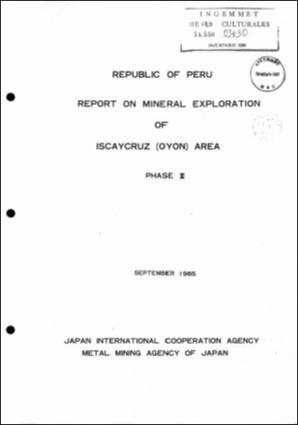- Repositorio Institucional INGEMMET
- Estudios e Informes técnicos
- Estudios y trabajos de investigación
Please use this identifier to cite or link to this item:
https://hdl.handle.net/20.500.12544/4467Report on geological survey of Iscaycruz (Oyon) area: Phase III
Sep-1985
This report summarizes results of the third year's work of the Mineral Exploration by means of drilling and tunnelling explorations carried out in the Iscaycruz Area (40 km2), the Republic of Peru. The purpose of this project is to examine relationship between geological structure and mineralization, and to confirm lateral and vertical continuity of the mineralized zone, by means of drilling exploration and tunnelling exploration in this area. The Iscaycruz Area had been extracted as a favorable area where economic ore deposits would be expected to be emplaced, by the results of the Mineral Exploration in the Oyon Area (860 km2 ), which was carried out during the period of three years from 1979 to 1981. The Iscaycruz Area is located about 150 km north of Lima, in the backbone range of the Western Andes. Geo1ogically, Mesozoic sedimentary rocks are wide1y distributed in this area, forming remarkable composit folded structure due to tight folding with the axes in the Andean direction, namely NNW-SSE. The Iscaycruz mineralized zone is located approximately 7 km south-southeast of Oyon, in the high mountain at the altitude of 4,700 m above sea level. The mineralization occurs in the limestones of the Santa Formation, about 50 to 100m in thickness, and continues about 12 km a1ong the strike. In this mineralized zone, ore deposits are divided roughly into two categories; the one is contact metasomatic skam type ore deposits represented by copper-zinc skam orebodies and the other is hydrothermal replacement ore deposits represented by copper-lead-zinc massive sulphide orebodies as well as by disseminated orebodies of lead and zinc in the siderite beds. The investigations in the present year, following the works in the last year, the tunneling exploration (crosscut of Adit-N, main tunne1 of Adit-S and two crosscuts of Adit-S) total length of which is 748 m, and the drilling (6 drill holes in the underground, 1 drill hole on the surface, total length 1 ,340m) were carried out in the Limpe area, in addition to the drilling carried out in the Limpe-South area (3 drill hales on the surface, total length 560 m). By the results of the drilling, high grade zinc orebodies associated silver, copper and lead minerals (the grade of Cu + Pb + Zn is up to 20%) was confirmed in the 4 hales; 3 hales in the Limpe area and 1 ho1e in the Limpe-South area. Considering the results of the drilling in this year with the data obtained in the past, the scale of the orebody in the Limpe area is estimated to be about 300 m in horizontal extension, more than 150 m in vertical extension and 10 to 30m in thickness. Also, it has been confirmed that there is a fair potentiality of the emplacement of high-grade copper-zinc ore deposit in the Limpe-South area. By the results of the tunnelling exploration, two portions of high-grade lead-zinc mineralization have been confirmed in the crosscut of Adit-S. The sizes and the ore grade of these mineralized portions are presumed to be better than those estimated from the data obtained by the drilling. The exploration works in the Limpe area during the period of these three years have brought about the full comprehension of the existence of fairly large scale of high-grade lead-zinc ore deposits in this area and it is thought that the purpose of the investigation has been completed in the subject area. As to the investigation of the next stage, it is recommended to carry out the survey for the planning of the development including every item in necessary fields for the investment to the development of mineral resources.
Japan International Cooperation Agency. | Metal Mining Agency of Japan
156 páginas
Files in This Item:
| File | Description | Size | Format | |
|---|---|---|---|---|
| JICA-1985-Report_geological_survey_Iscaycruz-Phase3.pdf | Reporte | 10.73 MB | Adobe PDF | View/Open |
This item is licensed under a Creative Commons License












